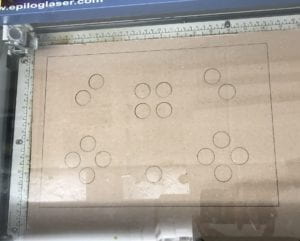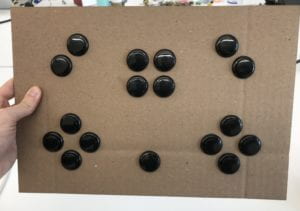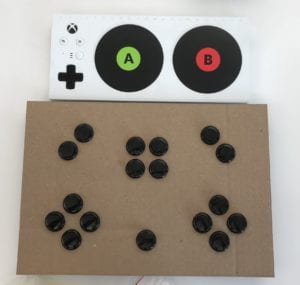Adaptive Force
Group information | Project Description | Competitive Analysis | Weekly Build Updates | Final Documentation
Group Information
- Team Name: Adaptive Force
- Group members:
- Nicholas (ITP)
- Zane (OT-MA)
- Saki (IDM)
- Jose
- Group members’ primary roles
- Nicholas: Fabrication
- Zane: Designer, Documenter
- Saki: Web Developer, Designer
- Jose: Community Partner, Advisor
Project Description
- Team Name Description: Adaptive Force
- We are a team that is adapting to our current conditions to force innovative solutions. Jose created the name and explained its meaning.
- Main Contact Person
- Nicholas
- Regular Meeting Schedule
- Every Friday at 2pm EST
- Project Goals
- We are modifying the Microsoft Adaptive Controller. We will solder buttons and create an enclosure that fits our users’ needs. Our client will be providing the materials and guidance. We will document our process, which will be showcased on Quad Gods. Additionally, we will create a WordPress website that synthesizes all of Jose’s past projects.
- Tools / Expertise to Complete the Project
- We will utilize Jose’s Microsoft Adaptive Controller and buttons. Additionally, we will create an enclosure, most likely in acrylic. In terms of expertise, we will employ the laser cutter and soldering methods. With Nick’s access to NYU ITP, he has all of the equipment at hand.
- Additional Tools / Expertise
- Jose sent out a file of an adaptive joystick for a keyboard that he would like to be 3D printed. We will modify the files slightly in order to create this small project.
- Project Timeline
- October 24: Pick up parts from Jose
- October 27: Midterm Presentation
- November 3: Begin design of video game controller and website
- November 10: Cardboard prototype
- November 17: Modify prototype
- November 24: Gather materials and structure website
- December 1: Populate website with content and create a controller
- December 8: Deliver controller and finalize a website
- December 15: Final documentation
- Broader Population Who Might be Interested
- Anybody in the disability community interested in gaming will benefit from our project. We will document our creation, which will be showcased for the public at https://quadgods.gg/about.
Competitive Analysis and Literature Review
POTENTIAL APPROACHES
Axis Controller
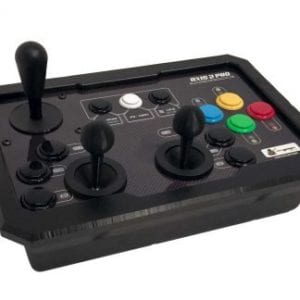
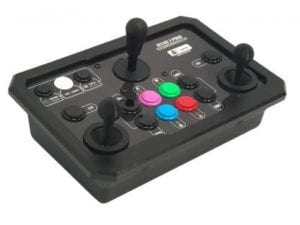
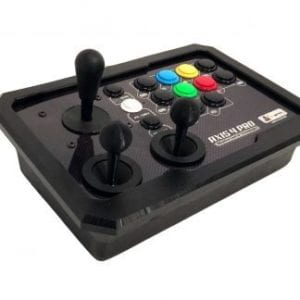
This is Axis controller, which is produced by the Ohio-based game company, Blue Tip Gaming. They offer several layouts of accessible gaming controllers to meet different needs of people with disabilities. Customers can choose it with Play Xbox 360, Xbox One, Playstation 3, and Playstation 4.Although Axis controller is a very well-made and high-end outlook, it costs $499 – $549 depending on if it’s with an expansion port. Xbox adaptive controller is less than $100 and even though we need to purchase buttons and joystick separately, our solution is much affordable as well as more customized layouts.
Logitech Adaptive Gaming Kit
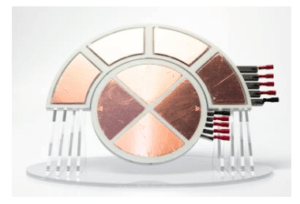
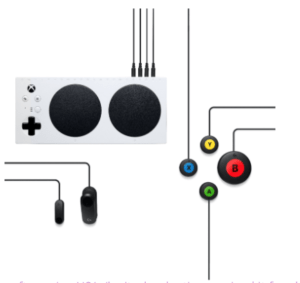
The Adaptive Gaming Kit is one of Logitech’s new designs for gaming to be more accessible to people with disabilities. It is a collection of 12 buttons and triggers designed to work with Microsoft’s Xbox Adaptive Controller. With these buttons that can be plugged into the Xbox Adaptive Controller, it can be arranged and attached to a hook and loop gaming board or set of ties to place them anywhere. By plugging these various accessories into the Xbox Adaptive Controller, a gamer can have a controller setup that is perfectly suited to their needs and liking.
Comparing it to what our group is making for Jose, our project will allow a more customized and functional gaming controller. Aside from the fact that the Logitech Adaptive Gaming Kit is a little bit pricey, it also doesn’t have a joystick that can make the gaming set more functional. In building our project, we will allow Jose to decide for button placement in order for it to be more personalized with his current function.
Freedom Wing
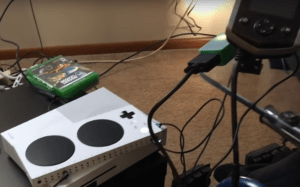
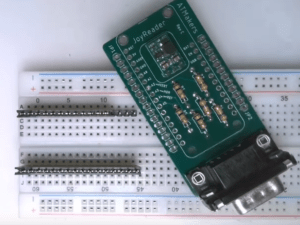
AbleGamers and ATmakers collaborated to create The Freedom Wing. The Freedom Wing is an adapter that allows users to plug a wheelchair joystick into their Xbox Adaptive Controller. AbleGamers will release the blueprints of the device for free so that anybody with the proper materials and tutorials may create their own. The process began when Bill Binko, the founder of ATmakers, met Steve Spohn at an ATmakers fair in Pittsburgh. They created the Joy Reader Adaptive Board, which reads the input from one of the proportional devices that is on people’s power chairs and feeds that directly into the Xbox Adaptive Controller. The printed circuit board that takes in the nine-pin connection and feeds that into the microcontroller that fits Adafruit’s feather standard.
They intentionally created a very simple board. The board consists of a voltage converter from Pololu, the Feather form factor, and some resistors that perform basic voltage dividing. Therefore, assemblers may easily utilize the board to create devices for people in their community. The whole board costs $30. The solution that our group is developing for Jose utilizes multiple input devices to control games. Whereas the Freedom Wing allows the user to control one mechanic of a video game with a power chair, such as steering a car in a driving game, our group’s solution will contain a button and joystick that account for the functionality of all buttons. Additionally, the solution for Jose will contain an enclosure that is separate from our client’s power chair.
RESEARCH PAPERS
Vickers, S., Istance, H., & Heron, M. J. (2013). Accessible gaming for people with physical and cognitive disabilities: a framework for dynamic adaptation. In CHI’13 Extended Abstracts on Human Factors in Computing Systems (pp. 19-24).
This paper is trying to develop a software framework to facilitate dynamic adaptation of computer games to different levels of physical and cognitive abilities.This framework will enable game developers to identify specific game tasks and to associate different input devices and interaction techniques with these. They take 2 approaches. The first approach is to make existing games more accessible through an extensible middleware solution. The middleware generates keyboard and mouse events and passes them into the operating system queue for processing. The second approach is to make future games more accessible through a development framework that can be implemented by the game or game engine by the developer. This is still an ongoing project so they are doing task analysis by building user profiles with people with different disabilities and different genres of games to develop the Game Accessibility Development Framework. With this framework, they expect to extend accessibility to games and reduce reliance on human programming configuration expertise for the individual gamer.
Lin, H. W. J., Aflatoony, L., & Wakkary, R. (2014). Design for one: A game controller for a quadriplegic gamer. Proceedings of the Extended Abstracts of the 32nd Annual ACM Conference on Human Factors in Computing Systems – CHI EA ’14, 1243–1248. https://doi.org/10.1145/2559206.2581334

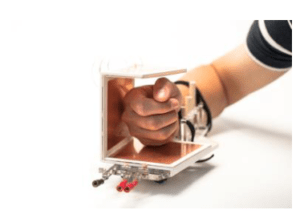
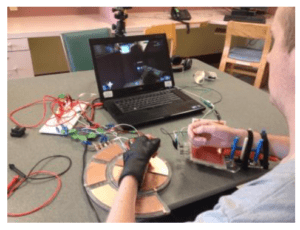
This paper explores utilizing digital fabrication and electronic prototyping techniques to build a game controller and a mouse for a quadriplegic patient (C6 level). Two products (mouse and keyboard) and DIY electronic prototyping techniques, which were developed in a collaborative effort between the designers and a quadriplegic teenager. They also discussed how personal fabrication can support Occupational Therapists (OTs) with their knowledge about digital fabrication and electronic prototyping which are typically beyond the scope of traditional Occupational Therapy. The researchers also highlight the importance of requiring patient’s expertise and participation in the design which is important in promoting user empowerment and preventing assistive technology abandonment. As a result, a series of prototypes, including a custom-build gaming keyboard and mouse with laser cut parts, were developed. In conclusion, considering the challenges OTs currently face, DIY, digital fabricating and prototyping techniques have the potential to fill the gap between technologists and OTs.
Yuan, B., Folmer, E. & Harris, F.C. Game accessibility: a survey. Univ Access Inf Soc 10, 81–100 (2010). https://doi.org/10.1007/s10209-010-0189-5
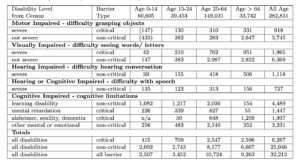
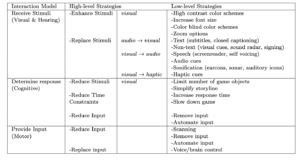
This paper surveyed the current state of accessibility in video games and provided relevant areas for more research. According to the classification in the study, visually impaired players are unable to perceive primary stimuli, hearing impaired players are unable to perceive secondary stimuli, cognitive impaired players are affected primarily by their ability to determine an in-game response, and motor impaired players are limited to provide input physically. A large number of users are excluded from playing video games due to a disability. The survey identified the number as 6.2 million. While W3C Web Content Accessibility Guidelines exist for the Internet, no such guideline exists for video games because they vary so greatly in content.
Motor impaired players, such as our client Jose, have difficulty with conventional game input devices such as a keyboard and mouse. Alternative input devices include switch inputs, brain wave controllers, head trackers, eye controllers, mouth controllers, and one-handed controllers. Tradeoffs exist between creating an accessible game from scratch and modifying an existing one. A developer does not need to worry about parts of the game that are expensive to create, such as graphics and audio, but the original gameplay is altered. The modified game may not be fun to play. Another point of consideration is game genres. Therefore, the researchers proposed that an accessible reference game for each genre could be developed. All games should support multiple types of input and be as inclusive as possible.
JOSE’S PREVIOUS PROJECT
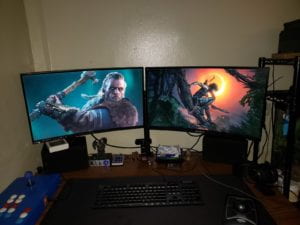
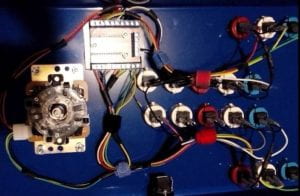
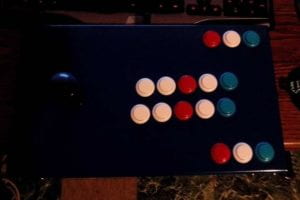
PARTS FOR THE CURRENT PROJECT
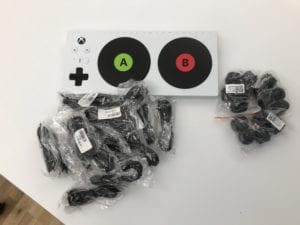
REFLECTION
Our proposed solution is an enclosure that will contain buttons that connect to an existing Microsoft Adaptive Controller. In the past, our client has created customized adaptive controllers. Our solution will be similar to the video game controllers that Jose utilizes in terms of size and placement. Since the box is an optional external device, the video game controller will not interfere with our client’s current daily activities. Additionally, the small and light enclosure may be placed anywhere. Therefore, the device will not interfere with other devices in our partner’s environment.
Weekly Build Updates
11/3/20
documentation
- We had a meeting with Jose to discuss and finalize the placement of the buttons
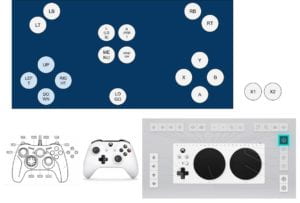
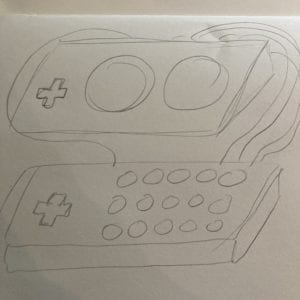
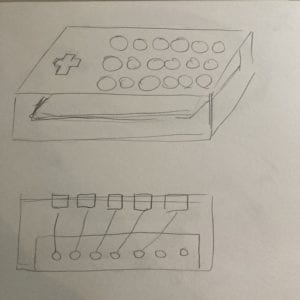
- We met with our fabrication teacher to discuss the best material
- We created measurements of all the parts
- We bought new buttons
- We researched the best enclosure for the controller (Link to the box)
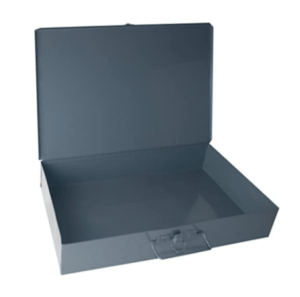
- Looked at the laser cutting guide for Adobe Illustrator
challenges
- The mounting for buttons only allows for a very thin layer of material. Aluminum or steel is the best option
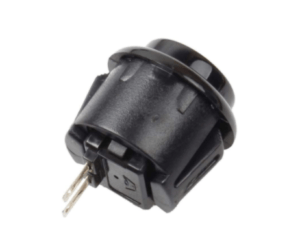
- Deciding between hiding the Microsoft Adaptive Controller inside the box or creating a separate controller
- Being able to customize the layout of the wires of the controller easily
- Buying more buttons and wires because we were short by 2
- Finalize placement of the buttons and the distances between them
- Finding a PC or Xbox to test the controller
user testing/prototype evaluation
- We will create a cardboard prototype, which we will show to him in our next meeting
future plan
- Create a cardboard prototype using the laser cutter
- Solder all the buttons to the wires
- Finalize the size of the box with the cardboard prototype that we made
11/10/20
Prototype Evaluation
Cardboard Prototype Button testing
We created the first prototype with cardboard to ensure that the button layout met Jose’s expectations. The file was created in Illustrator and we utilized a laser cutter to create holes for buttons. We showed the prototype to Jose in our weekly meeting and he approved the layout. The layout is good to go.
Button testing
We tested a button and wire, such as which side is positive and negative, to understand the structure so that we can start soldering all of the buttons and wires.
logo design
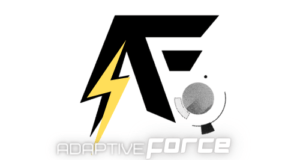
Our team name implies that we are currently adapting to our current conditions to force innovative solutions. The lightning bolt represents the strength and power of creation, which explains our team goals to create innovative solutions for our changing and adaptive world, hence the circle with lines revolving around the logo. The logo that we created was presented to Jose, who appreciated the design. He further suggested that we make a sticker out of vinyl and place that somewhere on the box to make the project more cool and attractive.
order box
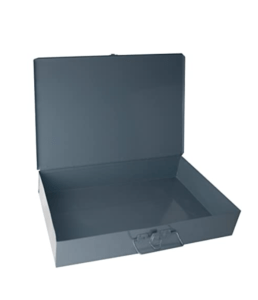
We ordered two boxes on Amazon for the final enclosure. We ordered two in order to have one as a back-up. We will be laser-cutting and drilling holes as soon as we receive the box.
challenges
- Drilling holes
- Drilling holes into the thin metal with a drill press is challenging. We will need to pad the box beforehand and apply special liquids
- The step drill bit at ITP goes up to 22mm, but we need to create holes that are 24mm. We may need to purchase a new step drill bit if we cannot find one
- We plan to laser cut the metal box to see where to drill the holes, but we need to figure out the correct power and frequency for the laser cutter
- Painting the box
- Our original plan was to paint the box but since the paint won’t last long, we decided not to paint the box for long-term use. Jose also likes the initial color of a box.
- Extra buttons
- Jose requested that two optional buttons be placed on both sides of the box. Since we cannot laser cut the hole placement on the sides, we will need to measure the box by hand
- Soldering buttons and wires
- We need to solder 21 buttons and wires. We need to ensure that the wires do not accidentally touch, which would cause the controller to malfunction
future plans
- Laser cutting the metal box to see where to drill the holes
- Soldering 21 button and wires
- Finding the correct drill bit
- Figuring out the best method to create the holes with the drill press
11/17/20
Documentation
- Dimple marks were placed on the metal box
- Finished soldering all button and wires
- Finished designing the box and the logo
- Making a plan for the next step
Dimple Marks
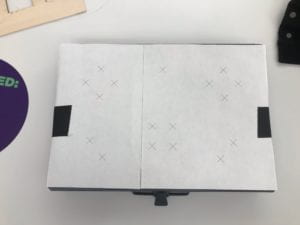
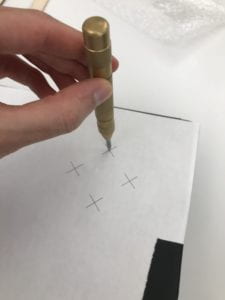
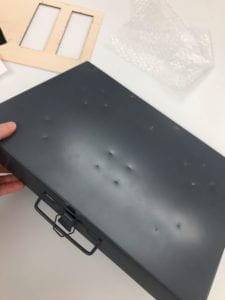
(left) Paper template on the metal box to place dimple marks, (Middle) Hand holding dimple tool, (Right) Dimpled metal box
Nick finalized the layout with the group and printed the template on paper. After taping the template on the box, he created 17 dimples on the top. The dimples show where to drill. Additionally, the 24mm step drill bit arrived.
Soldering
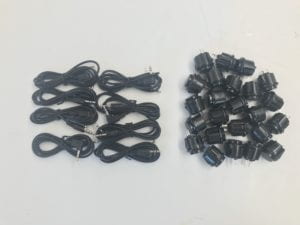
Buttons and wires before soldering
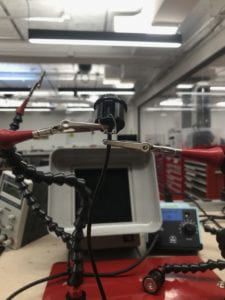
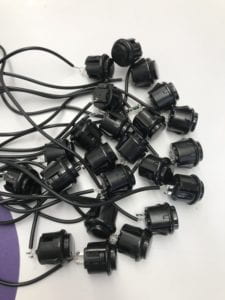
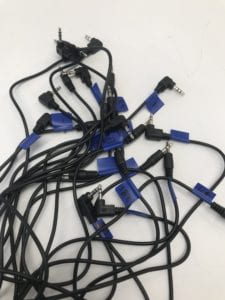
(Left) Soldering a button and wire, (Middle) after soldering, (Right) labeled button and wire
Zane and Nick soldered 21 buttons and wires at NYU ITP. They soldered an extra two for our client. They would cut the wire in half and attach the red wire to the left and the green wire to the right. After every five buttons, they would test to see if they worked on the Microsoft Adaptive Controller. Additionally, they also measured the holes for the five buttons on the sides. Jose wanted two optional buttons on each side and a hole in the back to connect the Microsoft Adaptive Controller to any device.
The flow of Logo Design

Revisions were made to the logo in order for it to have a color combination that suits the color of the box. Our team decided to have light blue and yellow colors.
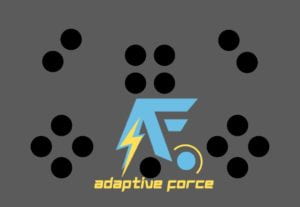
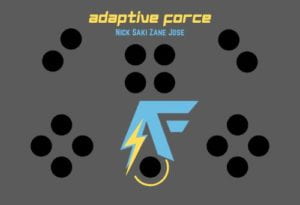
These two images are one of the designs we considered. The blue circle on the logo makes it confusing to distinguish between the button in the middle that’s why we decided to take it off and make the black button part of our logo instead. We also decided to transfer our team name on top of the box and initially added our names under it.
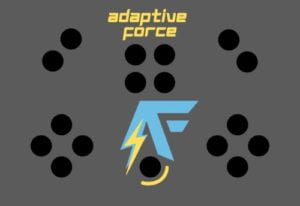
This is our final design template for our box. We decided to put our team name with one word on top of the other and we also removed our names and put it on the side of the box instead.
User Testing
- All buttons are working after soldering. We tested them by ourselves.
- Jose confirmed each process to make sure we are heading in the same direction.
Challenges
- Vinyl cutting using two colors
- Drilling holes without breaking the box
Future Plan
- Drilling holes in the box
- Vinyl cutting of the logo and team member names
- Setting up everything
- Making the final documentation for Quad Gods
11/24/20
Documentation
- Drilled holes for buttons
- Cut vinyl sheet for logo and names
- Set up all buttons and vinyl sheet
- Shipped the final box to Jose
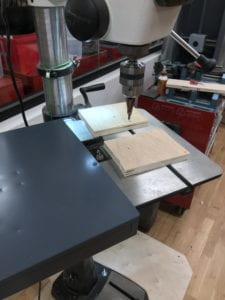
Metal box with two wooden jigs on a drill press
Nick first began fabricating the enclosure by creating two wooden jigs. Since the metal box may only be opened at a 90 degree angle and contained flaps on the sides, the jigs needed to be thicker.
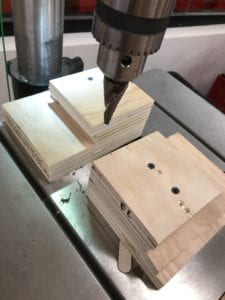
Two wooden jigs on a drill press
Nick sawed and inserted metal screws into plywood. When Nick drilled with the step drill bit, the hole for each button would be in the space between the thick jigs.
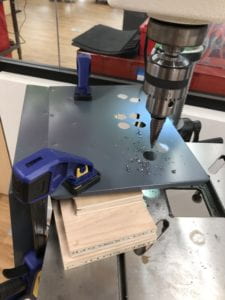
Metal box on two jigs on drill press. Half of the holes on the top of the box are created
Nick clamped the box and began drilling the dents in the closure that were created with the dimple tool. Since Nick drilled metal, he took the process slowly. With the step drill bit, he would insert one small hole that grew larger and larger. While Nick could move the drill press back and forth, he still could not drill the holes near the hinge. The angles of the box proved too difficult.
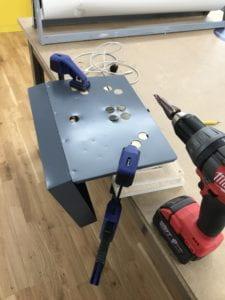
Clamped metal closure on two jigs with a screwdriver
To complete the box, Nick needed to drill the remaining holes by hand. He clamped the box on a table at NYU ITP, which gave him greater freedom of movement. Since drilling by hand is less accurate, Nick took his time in order to ensure the accuracy of the holes.
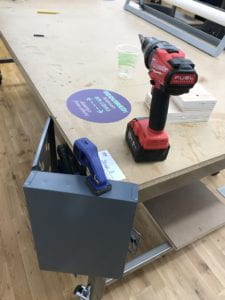
Hanging enclosure clamped to the corner of a table next to a screwdriver, wooden jig, and plastic cup
Jose requested two holes on both sides of the box, which proved to be highly challenging. In order to drill these holes, Nick carefully clamped the box to the corner of the table and pressed his hip into the box for support. In order to drill manually, Nick controlled the screwdriver with both of his hands. He used a high speed setting because metal is a hard material.
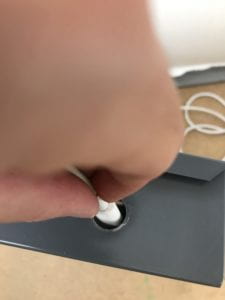
Hand inserting a wire into a hole on the side of a metal box
To plug the Xbox Adaptive Controller into a game console or PC, Nick drilled a hole on the hinge side. With the step drill bit, Nick created a small hole and paused after each larger size in order to find the best fit.
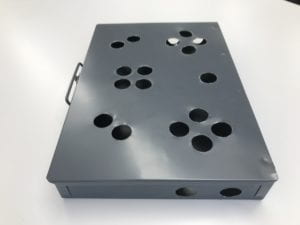
Metal box with seventeen holes on the top in the shape of a game controller configuration
At this point, the box is drilled! In the next step, Nick placed a button in each hole according to the original layout that we created with Jose.
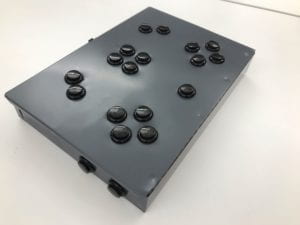
Metal box with black buttons in the shape of a game controller
After Nick inserted the buttons, he tested them with a PC. Then, he went to create vinyl based on the designs from Saki and Zane at NYU Makerspace.
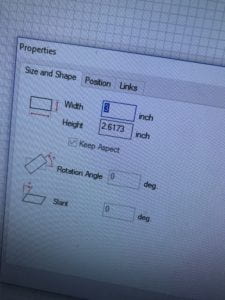
Width, height, rotation angle, and slant in properties in Roland CutStudio software
Nick imported the designs from Illustrator to Roland CutStudio. He altered the dimensions to fit the box perfectly based on the original mockup art. Nick used yellow and blue vinyl paper.
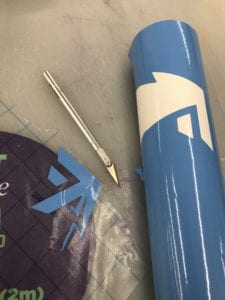
Blue Adaptive Force logo cut on transfer paper from blue vinyl paper next to X-Acto Knife
Nick placed the cut transfer paper on top of the sticker and smoothed it with a slider to remove air bubbles. He used an X-Acto knife to cut the desired shape of the image. Nick placed and peeled the transfer paper on the enclosure very slowly.

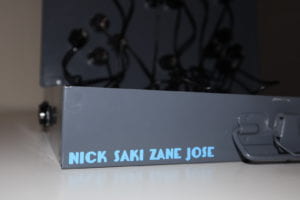
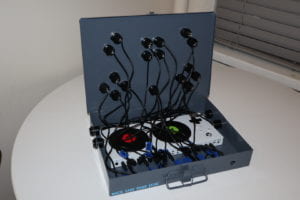
(Left) Completed adaptive force box with blue and yellow logo on a white table, (Middle) Blue vinyl with Nick, Saki, Zane, and Jose names on the hinge of the metal enclosure, (Right) Open metal box with Xbox Adaptive Controller, wires, and buttons inside
The box came out really well! We really like the color scheme. We showed the box to Jose on Friday and he approved. Afterward, we shipped the box to Jose. The controller should arrive either on Thursday or Friday.
Challenges
- Create a final fabrication guide by gathering all of our information
- Ensure that Jose received the package
Future Plan
- Jose will test the controller when he receives it and gives us feedback
- We are not sure if we can modify the controller when needed because of the time constraint
- Working on the final documentation
- Publishing the group website using NYU WordPress
- Putting the link and the brief description on Quad Gods
12/01/20
Accomplishments
- Jose received the controller
- Nick created a final template for the Adaptive Controller guide (https://docs.google.com/document/d/13gGJboMAFWV7aPm_jX68Nhv_jx1AN6BiZD4jnXWLfI0/edit?usp=sharing)
- Zane created a final graphic for the controller
Future Plan
- We will meet with Jose for our final meeting on Friday to receive feedback on the controller
- We will publish the group website using NYU WordPress
- We need to place the link and the brief description on the Quad Gods website
- We will create our final presentation video
Challenges
- Create a website with time remaining and send the link to Jose
- Gather all materials for final presentation
12/08/20
Final Documentation
Here is our final presentation video with closed captions.
We also created the Adaptive Force website that explains how to design and build a game controller using Xbox Adaptive Controller. It includes the step-by-step descriptions we went through. It will be submitted to Quad Gods and hopefully will be up on their website soon!
